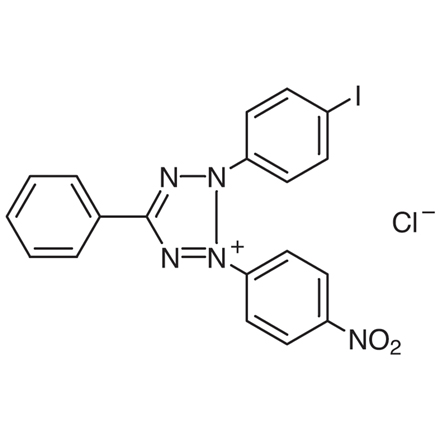Thermo Scientific™ 2-(4-Iodophenyl)-3-(4-nitrophenyl)-5-phenyltetrazolium chloride 95%
Catalog No :
CAS Number :
Brand :
In Stock
Specifications:
| Application | Colorimetric Assay | ||
| Storage Temperature | 2-8°C | ||
| Product Type | Laboratory Chemical | Forms | Powder |
| Product Brand | Thermo Fisher Scientific™ | ||
| Product Grade | Analytical grade | Formula | C₁₉H₁₃ClIN₅O₂ |
Thermo Scientific™ 2-(4-Iodophenyl)-3-(4-nitrophenyl)-5-phenyltetrazolium chloride (INT chloride, ≥95%) is a high-quality biochemical reagent frequently utilized as a redox-sensitive indicator. With purity ≥95%, it is optimized for precise and reliable detection of cellular metabolic activity, viability, and enzyme function in microbiological, biochemical, and cell biology research settings.
Chemical Identity and Specifications
- Chemical Name: 2-(4-Iodophenyl)-3-(4-nitrophenyl)-5-phenyltetrazolium chloride
- Commonly Known As: INT chloride, Iodonitrotetrazolium chloride
- CAS Number: 146-68-9
- Purity: ≥95% (high-purity grade)
- Molecular Formula: C19H13ClIN5O2
- Molecular Weight: 505.70 g/mol
- Appearance: Yellow to orange crystalline powder
- Solubility: Soluble in water, aqueous buffers, ethanol, methanol, and DMSO.
Principle and Mechanism of Action
INT chloride is a water-soluble tetrazolium salt functioning as a redox-sensitive dye. Metabolically active cells or microorganisms, specifically those with functioning respiratory enzymes (e.g., dehydrogenases), enzymatically reduce INT chloride to produce an insoluble, intensely colored purple or red formazan precipitate.
The quantity of formazan formed directly correlates with cellular metabolic activity, respiration, viability, and enzymatic efficiency, enabling both qualitative visual assessment and quantitative spectrophotometric analysis.
Applications and Use Cases
1. Microbial Respiration and Viability Assays
Primary Use:
- Assessing microbial viability and respiratory activity in bacteria, fungi, and yeast cultures.
Practical Example:
- Microbiologists use INT chloride to evaluate antibiotic efficacy. After treatment with an antibiotic, the presence or absence of a purple-red formazan precipitate indicates microbial survival or effective antibiotic-mediated inhibition.
2. Mammalian Cell Viability and Cytotoxicity Studies
Primary Use:
- Measuring cell proliferation, metabolic activity, and viability in mammalian cell lines, such as cancer cells or cultured primary cells.
Practical Example:
- Cancer researchers incubate cultured human cells (e.g., HepG2, Jurkat, or HeLa cells) with INT chloride to evaluate cytotoxic effects of anticancer drugs. The degree of colorimetric change (formazan formation) correlates precisely with the remaining viable cell population.
3. Enzymatic Activity and Metabolic Studies
Primary Use:
- Quantitative determination of enzyme activities, particularly mitochondrial and cytoplasmic oxidoreductases (dehydrogenases).
Practical Example:
- Researchers investigating mitochondrial function measure NADH-dependent enzyme activity. Addition of INT chloride allows colorimetric detection of enzyme-mediated INT reduction, providing accurate enzymatic activity data in biochemical and toxicological studies.
4. Environmental Microbiology and Ecotoxicology
Primary Use:
- Assessing microbial metabolic activity and respiration in environmental samples (soil, wastewater, sediments), crucial for environmental monitoring and bioremediation studies.
Practical Example:
- Environmental scientists employ INT chloride in soil microbial respiration tests to monitor ecological responses to contaminants or remediation treatments. Visible formazan formation indicates healthy microbial activity.
5. Biofilm Formation and Activity Assays
Primary Use:
- Qualitative and quantitative detection of biofilm formation, biofilm growth inhibition, or antimicrobial resistance testing.
Practical Example:
- Medical researchers investigating biofilm resistance test medical implants or catheters by incubating microorganisms with INT chloride. Active biofilms generate easily measurable formazan crystals, clearly demonstrating microbial colonization and potential antimicrobial resistance.
Advantages and Key Benefits
- High Purity (≥95%): Ensures consistent, reliable experimental outcomes.
- Sensitive Indicator: Detects subtle changes in metabolic activity, facilitating precise and reproducible quantification.
- Rapid and Simple Protocol: Provides quick visual or spectrophotometric results, ideal for high-throughput screening.
- Broad Applicability: Versatile reagent suitable for microbial, mammalian, environmental, and biochemical studies.
Handling, Storage, and Stability
- Store at 2–8°C (refrigerated conditions recommended).
- Protect from direct light, moisture, and contamination.
- Follow laboratory-standard safety practices for handling chemical reagents.
Intended Users
- Research and diagnostic microbiology laboratories
- Biotechnology and pharmaceutical industries
- Environmental testing laboratories
- Cell biology and cytotoxicity researchers
- University research facilities focusing on metabolism and bioactivity studies
Thermo Scientific™ 2-(4-Iodophenyl)-3-(4-nitrophenyl)-5-phenyltetrazolium chloride (≥95%) offers reliable performance, precise measurements, and versatile applications, making it an essential reagent for researchers investigating microbial, cellular, environmental, and enzymatic processes.
- Pack Size: 1g 5g




 0
0
